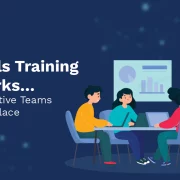
How Can Colleges Support Continuing Education?
Table of Contents:
- Introduction
- The Proliferation of Digital Technology
- What is Continuing Education?
- What are the Benefits of Continuing Education?
- How Can Colleges Support Continuing Education?
- Conclusion
Introduction
Higher education has undergone a paradigm change. Education has transcended the conventional barriers of the classroom and entered the learners’ living room. Students can conveniently switch on a digital device and pick up concepts that matter, uniquely and excitingly. In such an environment, continuing education has become a necessity rather than a luxury.
There’s no denying that the pandemic has shrunk the job market, and professionals need higher skills and qualifications than before to succeed. While remote work was slowly gaining traction, it started growing at a breakneck speed after the pandemic. Sadly, students coming out of higher educational institutions are inadequately prepared to handle the changing requirements of the industry. Continuing education can help bridge the gap between formal education and work and make the campus-to-corporate transition super smooth.
So, what is continuing education, and what are its benefits? Read on to find a comprehensive review of continuing education and how top organizations are creating a solid roadmap to make their continuing education delivery methods more streamlined and accessible.
The Proliferation of Digital Technology
Before understanding the benefits of continuing education and strategies to implement it, let’s explore the reasons why digital technology has become so vital for improving the quality of continuing education:
- 65% of teachers admitted to using digital learning tools in their classrooms.
- 87% of teachers use digital learning tools more than one day every week.
- $803 million: The total Venture Capital funds collected by educational technology companies in the U.S.
- $12.6 billion: The amount education companies will spend on Augmented Reality (AR) and Virtual Reality (VR) by 2025.
- 3X – The growth of educational technology in the past decade.
- 75% of teachers firmly believe that digital learning content will completely wipe out printed textbooks within ten years.
- 95% of undergraduate learners own digital devices, such as laptops or smartphones.
- $3 billion: The amount schools spend on digital content for students.
The data presented above must have convinced you of the role of digital technology in education. Let’s now move to the core focus of this topic— understanding continuing education and its many benefits.
What is Continuing Education?
Continuing education refers to one or many courses that develop students’ knowledge in a professional field of study. Continuing education is generally offered by colleges, universities, and sometimes, schools. Although continuing education is typically non-credit-based, some educational institutions offer certificate or diploma courses as well. These courses are usually taken by professionals with a formal high school or university degree or diploma. Employers and higher education institutions do not mind reducing the workload or study load of learners pursuing continuing education courses.
Also Read: Role of Technology in Higher Education Curriculum Development
What are the Benefits of Continuing Education?
Continuing education opens a new era of professionalism for students and companies. Here are the top benefits of continuing education:
1. Higher Money-Making Opportunities
Continuing education helps professionals or students to upskill themselves. Data published by the U.S. Bureau of Labor Statistics show that educational qualifications are directly related to a professional’s earning potential, meaning the higher the skills, the better the opportunities.
While companies are certainly investing more resources into continuing education, students willing to join the corporate bandwagon may also take these courses to enhance their visibility in the job market. If students have already upskilled themselves, companies recognize their value and offer them higher salaries and better perks.
Hence, continuing education increases students’ value in the market and convinces employers that they are the best fit for the position.
2. Better Networking Opportunities
Continuing education brings students closer to a diverse audience. Even though the courses are primarily online, they can still meet like-minded individuals from all over the world. As learners come together to work on projects while forming groups, they become a team and stay connected for the rest of their lives.
Continuing education also makes learners a part of study groups, conferences, and membership societies so that they can explore various facets of the course to sharpen their skills and knowledge. For example, if a student takes up a course on search engine optimization, they might collaborate with a like-minded professional to set up a business.
Since connections are an integral part of success, continuing education can help students expand their base and level up their networking skills.
3. Improve Students’ Proactivity
Perhaps the most significant benefit of continuing education is that it keeps students happy. Organizations with happy individuals progress faster. Research shows that reading new things can enhance brain capacity and make people more agile. Usually, learners’ ability to remember things reduces as they grow up. Continuing education can not only contain the damage but also make learners’ brains more productive. Learning is a mental exercise that stimulates the nerves inside one’s brain to help them utilize their cognition to the fullest.
Some studies have also shown that the higher one’s education, the higher their lifespan. People studying more keep themselves busy with healthy behaviors and are less prone to diseases.
Hence, besides improving students’ job prospects, continuing education can also improve their health by making them happier.
How Can Colleges Support Continuing Education?
Now that you understand the significance and benefits of continuing education, you must be willing to discover the best ways to implement continuing education in your educational institution. Here are some time-tested tips to enrich your institution by designing an impeccable continuing education plan:
- Offer Learning Content as per the Latest Industry Standards
A wise way to offer the best-continuing education courses is by looking at what your competitors are doing. You can browse their course catalogs to find what makes them stand out. Additionally, make sure to improvise the course content based on the audience profile.
- Modernize the Learning Experience for Students
Using the right technology and tools can make an ordinary training program extraordinary. Educational content delivery platforms can give you an edge by simplifying content creation and making delivery seamless to help you enhance the student learning experience.
- Offer Personalised Learning to Suit Every Learning Style
An excellent benefit of technology is that you can suit your content to the needs of your learners. While teachers generally take a one-size-fits-all approach in a traditional classroom, online training delivery methods allow you to refine the content by capturing feedback and tailoring the content accordingly.
- Opportunity-Driven Education Culture
Continuing education is highly opportunity-driven and lets institutes optimize their existing resources. You can use the teaching methodology adopted by the best teachers in your institute to train others. Hence, this approach allows you to improve your educational output and make education more impactful.
- Self-Assessment Options to Track Their Progress
A fantastic feature of continuing education is that it transfers the ownership of learning to the learner. You can create assessments that allow learners to test their understanding quickly. Be it capsule assessments or extensive class tests, self-assessments can go a long way in helping students track their progress and hone their skills.
Also Read: Top 6 Ways to Improve Efficiency with RPA in Higher Education
Conclusion
Continuing education is the need of the hour. With industries becoming highly competitive by the day, enabling quick learning has become imperative. It is important to eliminate the hassles of designing an industry-ready continuing education course by presenting the right cues to make your courses more appealing and targeted.


